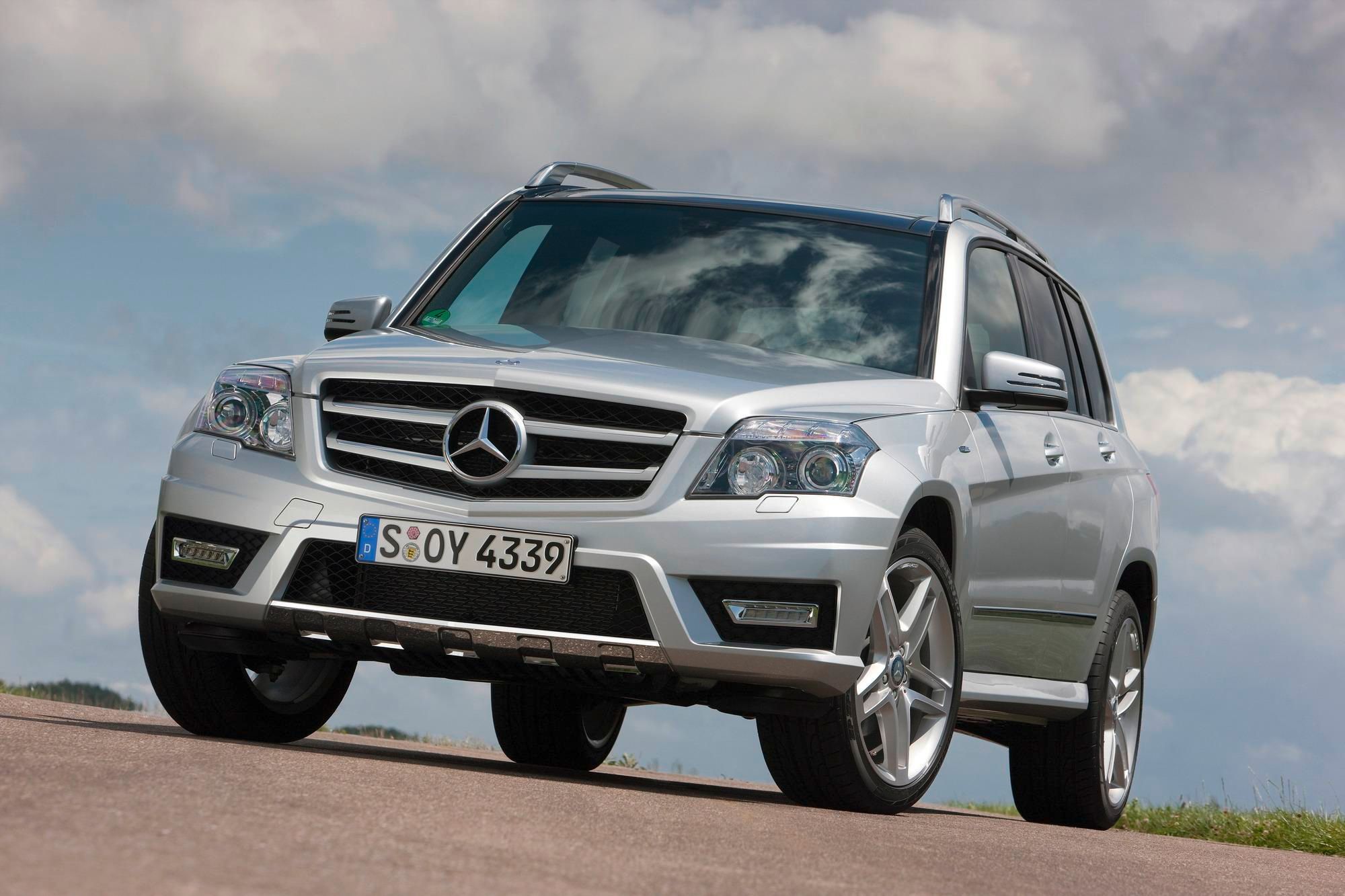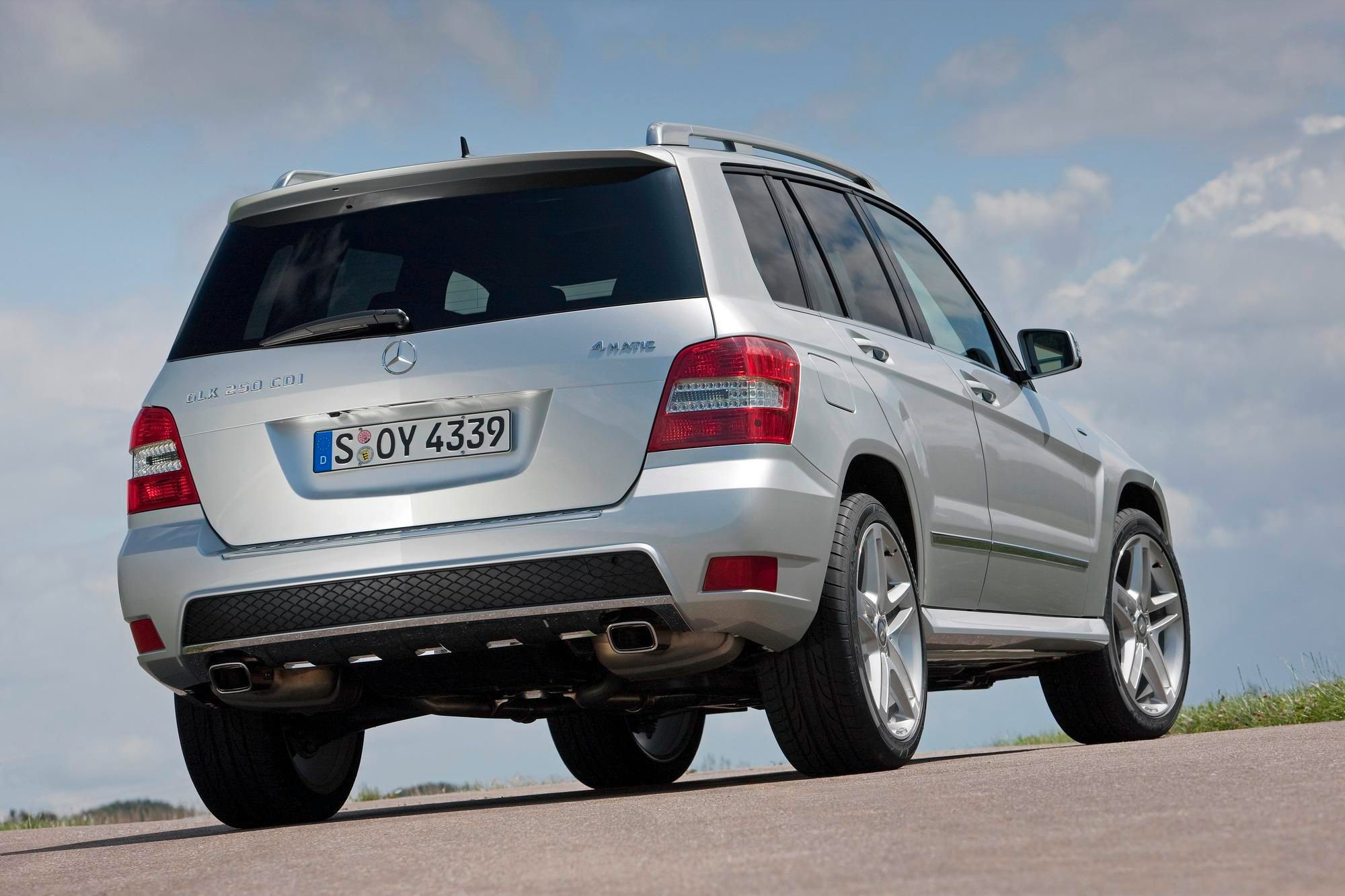Mercedes has added two new models to the GLK line-up: the GLK 250 CDI 4MATIC BlueEFFICIENCY and the GLK 220 CDI BlueEFFICIENCY.
The GLK 250 CDI 4MATIC is powered by a four-cylinder diesel engine that delivers 204 hp and 500 Nm of torque. It sprints from 0 to 60 mph in just 7.9 seconds, and can hit a top speed of 132 mph.
The GLK 220 CDI BlueEFFICIENCY is powered by a four-cylinder diesel engine that delivers 170 hp and 400 NM of torque. It sprints from0 to 60 mph in just 8,5 seconds, while top speed go up to 127 mph.
Press release after the jump.
mercedes-glk-220-cdi-and-250-cdi-4matic-blueefficiency
- Make: Array
- Model: mercedes-glk-220-cdi-and-250-cdi-4matic-blueefficiency
2010 Mercedes GLK 220 CDI and 250 CDI 4MATIC BlueEFFICIENCY
- Make: Array
- Model: 2010 Mercedes GLK 220 CDI and 250 CDI 4MATIC BlueEFFICIENCY
- [do not use] Vehicle Model: Array
Press release
While one car boasts outstanding driving performance and high fuel efficiency, the other offers high fuel efficiency and good handling. What is the difference between the two? The sporty handling dynamics set the tone in the all-wheel drive GLK 250 CDI 4MATIC BlueEFFICIENCY: The modern, four-cylinder diesel with 150 kW (204 hp) and an impressive 500 Nm of torque guarantees top acceleration and flexibility. In fact, this model has the most powerful four-cylinder diesel engine in the SUV world. The rear-wheel drive GLK 220 CDI BlueEFFICIENCY with the familiar 125 kW (170 hp) diesel engine, on the other hand, impresses with even better fuel economy (consumption as low as 6.0 l/100 km) while at the
same time delivering great performance.
The new models underscore the leading position of the distinctive yet compact GLK. Whereas the GLK 250 CDI 4MATIC featuring permanently engaged all-wheel drive, 7G-TRONIC transmission and the segment’s most powerful four-cylinder diesel engine augments the world of top-of-the-range compact SUVs, the GLK 220 CDI with rear-wheel drive and six-speed manual transmission offers maximum fuel economy. It consumes only between 6.0 and 6.4 litres of diesel fuel per 100 kilometres and combines these low consumption values with good performance. The rear-wheel drive vehicle accelerates from zero to 100 km/h in 8.5 seconds and reaches a top speed of 205 km/h. The GLK 250 CDI4MATIC completes the sprint to the 100 km/h mark in 7.9 seconds and doesn't stop accelerating until reaching 213 km/h. This sports car-like performance does not come at the typical cost of higher consumption. The diesel consumes only 6.7 litres per 100 kilometres on average.
GLK 250 CDI 4MATIC: The fun yet frugal power SUV
The GLK 250 CDI 4MATIC BlueEFFICIENCY brings the world’s most powerful four-cylinder diesel engine for an SUV to the Mercedes-Benz range. The new 2143 cc diesel engine with direct fuel injection produces 150 kW/204 hp and 500 Nm of torque in the GLK for outstanding performance. Just as impressive as the sprint times and the top speed is the GLK’s top-gear acceleration. Thanks to its high torque, which is already present at 1600 rpm, the GLK 250 CDI 4MATIC accelerates powerfully when overtaking, requiring only 7.0 seconds for the sprint from 80 to 120 km/h. In spite of its great performance, this GLK model is very economical to drive, consuming only 6.7 litres of diesel fuel on average per 100 kilometres (combined NEDC consumption, preliminary value). This makes the GLK significantly more fuel efficient than comparable models in this performance class. The vehicle produces CO2 emissions of 176 grams per kilometre.Furthermore, it not only meets the EU5 emissions standard but also has the potential to fulfil the EU6 limits as well as the BIN 5 requirements in the USA.
Diesel engine with advanced common-rail technology
One of the hallmarks of the new diesel engine in the GLK 250 CDI 4MATIC BlueEFFICIENCY is the increased maximum rail pressure of 2000 bar. This increase in pressure potential is a prerequisite for increasing engine output and torque while at the same time significantly reducing untreated emissions. Newly developed piezo injectors take advantage of the fact that piezoceramics change their crystal structure - and therefore their thickness - in a matter of nanoseconds (one nanosecond = one billionth of a second) when electrical voltage is applied. The new injectors are equipped with a stack of thin piezoceramic layers (called the “piezo stack”) to enable them to achieve a sufficient overall stroke from the very small stroke per layer. The injector needle is actuated directly, so that the fuel injection can be adjusted even more precisely in line with the current load and engine speed situation. Another key factor behind the low emissions, low fuel consumption at full load and peak output is the ignition pressure of 200 bars, which puts the four-cylinder diesel at the head of the field when it comes to diesel engines for passenger vehicles.
A two-stage supercharging system comprising a small high-pressure (HP) turbocharger and a large low-pressure (LP) turbocharger ensures that the optimum charging pressure is always available. The two turbochargers are connected in series, and each has a turbine and a compressor driven by this turbine for the combustion air. The HP turbine is located directly at the exhaust manifold and initially allows exhaust gas to flow through it, causing it to rotate at up to 215,000 revolutions per minute. The HP turbine housing features an integral bypass duct, which can be opened or closed by means of a wastegate triggered by a vacuum unit. If the flap is closed, the entire exhaust stream flows through the HP turbine so that the exhaust gas energy is initially available to drive the HP turbine. This allows the optimal boost pressure to be developed even at low engine speeds. As the engine speed increases, the wastegate opens, distributing the exhaust gas energy to the turbines with optimum efficiency. Downstream of the HP turbine, the two exhaust gas streams reconverge, and the remaining exhaust gas energy drives the LP turbine at a maximum speed of up to 185,000 revolutions per minute. At intermediate engine speeds, the wastegate of the HP turbine is opened so wide that the HP turbine ceases to perform any appreciable work. This allows the full exhaust gas energy to be directed with low losses into the LP turbine, which then does all of the turbine work.
The two compressors are likewise connected in series and are in addition connected to a bypass duct. The combustion air from the air filter first flows through the low-pressure compressor, where it is compressed as a function of the LP turbine’s driving power. The compressed air then flows into the high-pressure compressor, which is coupled to the HP turbine, where it undergoes further compression for a genuine two-stage supercharging process.
The key benefit of this intelligent, on-demand control is the improved cylinder charging and, consequently, high torque even at low engine speeds. What's more, fuel consumption is reduced. During normal operation, the advantages of this concept can be seen in the harmonious driving characteristics with no turbo lag, a good torque curve across the entire engine speed range, spontaneous throttle response and noticeably improved performance. As a logical supplement to the turbocharger system, Mercedes-Benz installs a larger intercooler that reduces the temperature of the compressed and heated air by as much as 140 degrees Celsius so that a larger volume of air can enter the combustion chambers.
The newly developed exhaust gas recirculation valve (EGR valve) works like a rotary disc valve and precisely controls the quantity of fresh air and recirculated exhaust air to effectively reduce emissions of nitrogen oxides.
Sacrifice without detriment: The GLK 220 CDI BlueEFFICIENCY with rear-wheel drive and six-speed manual transmission
The powerful, yet economical four-cylinder diesel engine in the GLK 220 CDI BlueEFFICIENCY is another unit from this same generation of engines. It produces 125 kw/170 hp and, depending on the equipment level, consumes only between 6.0 and 6.4 litres of diesel fuel per 100 kilometres (combined NEDC consumption, preliminary value). CO2 emissions are from 158 to 168 grams per kilometre. Not only does it meet the current EU5 emissions standard, this version also has the potential to fulfil the EU6 limits as well as the BIN 5 requirements in the USA.
In combination with a tried and tested six-speed manual transmission and rear-wheel drive, the engine of the GLK 220 CDI BlueEFFICIENCY exudes a lot of power and responds to the driver’s commands with a great deal of agility. It boasts good pulling power and, like the more powerful variant, is extremely smooth running for a four-cylinder diesel engine. In addition to good performance, the engine generates an impressive torque at low engine speeds: Peak torque of 400 Nm is available over a wide rev range from 1400 to 2800 rpm, making it possible to drive very fuel efficiently at low engine speeds in everyday driving situations. The rear-wheel drive vehicle sprints from zero to 100 km/h in 8.5 seconds and reaches a top speed of 205 km/h.
The GLK 220 CDI BlueEFFICIENCY is also available with the 7G-TRONIC seven-speed automatic transmission as an option.
BlueEFFICIENCY: Efficient measures for reducing fuel consumption
Like all BlueEFFICIENCY models from Mercedes-Benz, the two new GLK models also feature an extensive package of measures that help to reduce fuel consumption. Measures besides the diesel engine with direct injection and the low-friction powertrain include weight savings achieved through the use of high strength and ultra high strength steels in the bodyshell and weight-optimised alloy wheels. Aerodynamic side mirrors and underbody panels lower the air resistance, and newly developed 235/60 R 17 V tyres reduce rolling resistance. A regulated fuel pump and the energy-saving electric power steering system further reduce the GLK’s fuel consumption. Thanks to a fuel-consumption computer and a display showing current fuel consumption, GLK drivers can check their fuel consumption at any time and adjust their driving behaviour accordingly.
New equipment details for the new model year
New equipment options are available for the distinctive compact SUV. These include convenience features such as KEYLESS GO or - in combination with the COMAND APS multimedia system - a reversing camera with static help lines that make it easier to manoeuvre in tight quarters. Effective immediately, all COMAND infotainment systems are able to receive digital radio (DAB). Passive safety was further improved by the standard pelvisbag*, which provide additional protection to the pelvis in the event of a collision. The crash-responsive exit assistant is a new function of the Memory equipment package that makes it easier to exit the vehicle after an accident by automatically moving the power-adjustable steering wheel to its highest position. The optional Intelligent Light System (ILS) now includes LED* daytime running lights, and 19 inch winter wheels have been added to the portfolio for the coming cold season.
Customers can choose ARTICO, a particularly robust, yet breathable synthetic leather for the interior of the GLKs.Also available is the luxurious designo line of two-colour leather appointments in black/light brown and black/corteccia. A steering wheel covered in easy-to-grip nappa leather* is standard in all models.
Drivers with sporting ambitions can select EXTERIEUR*, a new AMG sports package based on the existing sports package. The scope of supply includes, in addition to the standard sports package, AMG-specific front and rear aprons with optical underbody protection in chrome, body-colour side skirts, a radiator grille with two smooth chrome louvers, a chrome rub strip and 20 inch, twin-spoke AMG alloy wheels asymmetrically shod with 235/45 R20 tyres up front and 255/40 R20 tyres in the rear.




